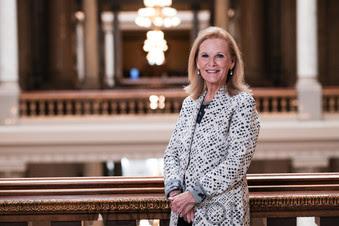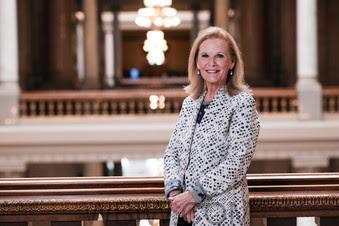
INDIANA – Indiana Commissioner for Higher Education Teresa Lubbers delivered her final State of Higher Education address today. This year’s address focused on the imperative to transform higher education to meet the diverse needs of learners and a changing economy.
As Lubbers concludes her tenure as Indiana’s Higher Education Commissioner in March, her tenth-annual address provided a reflection of her 13 years of service while considering the challenges and opportunities facing higher education. Her address was delivered in the south atrium of the Indiana Statehouse in front of an audience of education, government, business, and community leaders.
“Higher education is often labeled as not being adaptable, but I believe this is a lagging narrative,” said Lubbers. “Over the past two years due to the impact of COVID, we’ve seen institutions adjust how they deliver education and respond to changing needs.”
Affordability
The most expensive proposition for a student is debt – especially debt that is not associated with the completion of a degree or credential. Additionally, the cost of higher education – whether it’s perception or reality – is causing more people to question whether college is worth it.
State lawmakers are committed to addressing college costs through sustained and generous financial aid benefits – nearly $400 million annually. Additionally, Indiana ranks first in the Midwest and fifth in the nation in need-based financial aid and we’ve seen some of the lowest rates of tuition increases in the nation over the past 10 years. However, institutions must find ways to continue to bend the cost curve, and that’s happening on many campuses. When tuition is stabilized, more enrollments are likely to increase.
“As new providers enter the higher education space it should be expected that competition will drive down costs,” said Lubbers. “And that’s a good thing at a time when more Hoosiers will need education beyond high school.”
Accessibility and Flexibility
Education must be more accessible and flexible for those who are balancing jobs, families and other responsibilities. While residential, in-class or hybrid learning experiences remain the best option for many, we must make higher education work for people who need different pathways to attain the benefits of higher education.
However, quality must be preserved regardless of the setting, length of the program, the age or life circumstances of the learner or the credential that is earned.
“If COVID taught us anything, it was that institutions must and can be nimble in how they deliver education,” said Lubbers.
Value Proposition of Higher Education
Indiana’s college-going rate is at its lowest point in more than 10 years at 59 percent. For low-income, Black, male, and Hispanic and Latino students, the number is significantly lower. The Commission is doing a deep dive into the perceptions of higher education to develop a better understanding of why college-going rates in Indiana are declining.

The Commission’s research showed that a majority of Hoosiers — around 80% — feel “favorable” toward college. However, many people reported that they didn’t think college was the right path for their lives or just not necessary.
“While that may be true for some who attain credentials of value in other ways, the truth is that it is a risky proposition to walk away from the promise of education beyond high school,” said Lubbers.
Indiana as a Leader
In addition to highlighting the challenges confronting higher education, Lubbers shared examples of how Indiana is a leader in this time of revolutionary change.
- Advocating for early college credit, through working with partners in K-12, nearly two thirds of Hoosier students graduate high school with some for of early college credit. Additionally, a growing number of high school graduates have earned an Indiana College Core certificate, which is a block of 30 credit hours of general education coursework that can be transferred seamlessly to all public Indiana institutions and some private schools.
- Closing achievement gaps for low-income, minority and first-generation students, through the 21st Century Scholars program. Scholars have already exceeded the college-going rate across all populations by nearly 30 percentage points.
- Building partnerships, by being the first state to join the national organization, NC-SARA, to reduce the costs and ensure quality of distance education across state lines. Also, the Commission engaged Credential Engine – a platform designed to allow learners to show their skills and knowledge and explore career options while employers will be better able to understand which skills and competencies potential employees have mastered through their credentials.
- Aligning funding, programs and polices of workforce preparation, through the Governor’s Workforce Cabinet. Over 57,000 Hoosiers have enrolled in a high-demand certificate program and nearly 32,000 Hoosiers have completed a certificate for free through the Workforce Ready Grant, leading to an almost $7,000 annual wage gain.
“We know higher education is capable of change,” said Lubbers. “By prioritizing overall quality and focusing on affordability, access and relevance, Indiana’s higher education system will be poised to adapt to future uncertainties.”
To read the full 2022 State of Higher Education Address, click here.



